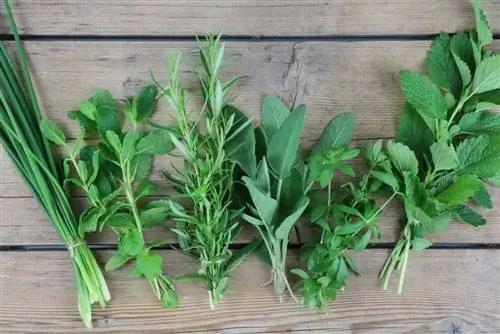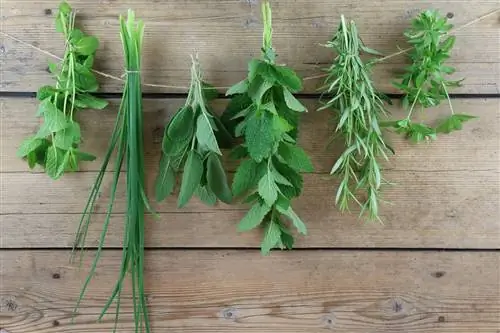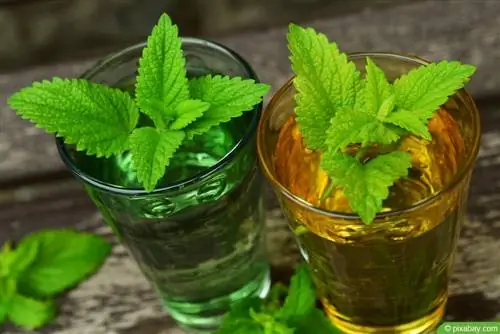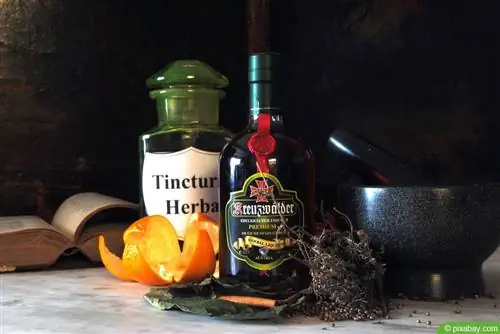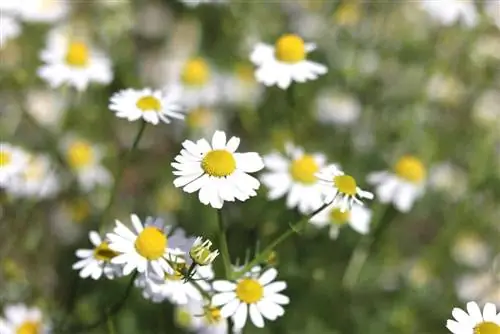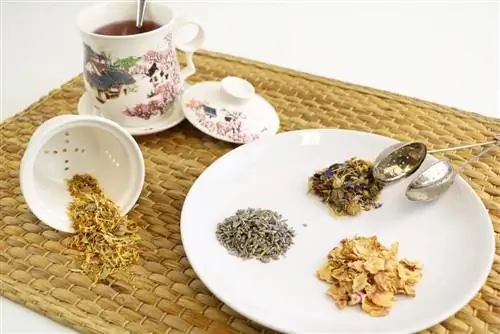- Author admin [email protected].
- Public 2023-12-17 03:39.
- Last modified 2025-01-24 12:45.
With an optimal supply of nutrients, hobby gardeners are rewarded with abundant flowers from flowering plants and high harvest yields from crop plants. Garden retailers have the right fertilizer for every type of plant. However, if you want to avoid chemicals in your kitchen garden as much as possible and are looking for cheaper alternatives, you can prepare natural fertilizer yourself. We'll show you how easy it is!
Why fertilize?
The most important plant nutrients are nitrogen, magnesium, phosphorus, potassium, calcium and sulfur. It is possible to supply missing nutrients by using commercially available fertilizer. However, fertilizers are expensive and contain a lot of chemicals. For centuries, people have been preparing effective fertilizers from herbs and natural raw materials. We have put together 9 recipes for all hobby gardeners and self-sufficient people who prefer organic gardening and want to save money at the same time.
Manure, broth, tea or herbal extract?
Depending on how you prepare it, you can make manure, broth, tea or extracts from herbs and plant parts. Manure is generally prepared with cold water. After about three days, fermentation begins and the active ingredients can develop. It needs to be stirred daily. The manure can be used after an average of 14 days. To make vegetable broth, the herbs are boiled and poured through a sieve.
Plant broth is filled into bottles and sprayed onto the plants in the specified dilution to strengthen them or to ward off pests and diseases. To make tea, plant parts are poured over with boiling water and strained. Plant teas can be used for pest control or foliar fertilization. Teas are also suitable as a compost additive. If you want to make your own herbal extract, put chopped herbs in a container, fill it with cold water and pour the extract through a sieve a day later. Herbal extracts are used immediately and undiluted.
Field horsetail broth
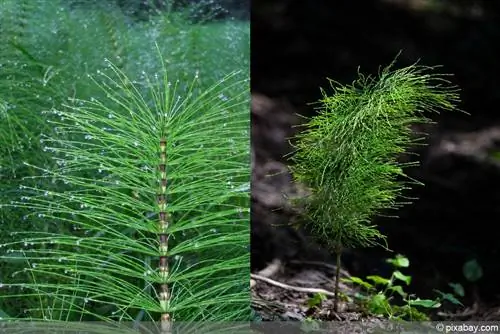
Field horsetail (Equisetum arvense) in the garden is annoying. With roots up to 1.5 meters long, it is almost impossible to completely eradicate the weeds. A good idea is to take advantage of the positive properties of field horsetail and use it to make herbal fertilizer.
Ingredients
- 150 grams of dried or 1 kilogram of fresh field horsetail
- 5 liters of water for preparation
- 20 liters of water for dilution
Preparation and application
- Cut field horsetail into small pieces
- Soak in 5 liters of water for 24 hours
- Cook for 45 minutes
- let it cool down
- pour through a cloth
- dilute with water in a ratio of 1:5 and spray on the plants
Comfrey Manure
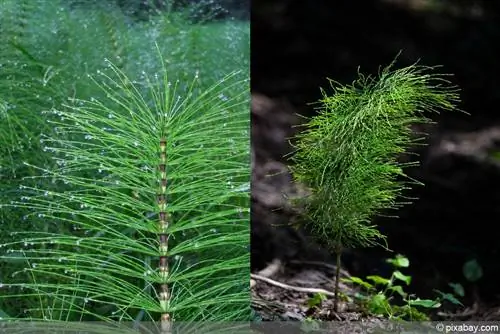
Comfrey (Symphytum officinale) is known as a home remedy for venous diseases. The fast-growing plant is also used in the garden as a herbal fertilizer.
Dry production
Ingredients
- Comfrey leaves
- two buckets, one with several holes in the bottom
Preparation and application
- Put the comfrey leaves in the perforated bucket and weigh it down with a brick
- put this bucket in the second bucket
- liquid drips from the inner bucket into the outer bucket
- Fill the liquid into bottles and pour it onto the plants at a ratio of 1:50
Tip:
Harvest comfrey leaves outside of flowering season to avoid damaging the plants.
Liquid Manufacturing
Ingredients
- Comfrey leaves
- 10 liters of water
Preparation and application
- Roughly chop comfrey leaves
- Pour 10 liters of water over it, cover so that it is permeable to air
- Let it steep for 20 days
- Manure is ready when no more foam forms
- water the plants at a ratio of 1:10
Tip:
You can not only make liquid fertilizer from the fleshy comfrey leaves. Add chopped comfrey leaves to the planting hole when planting heavy feeders such as squash, tomatoes or cabbage. This gives the young plants a perfect start. Roses also benefit from the addition of finely chopped comfrey leaves.
Stinging nettle manure
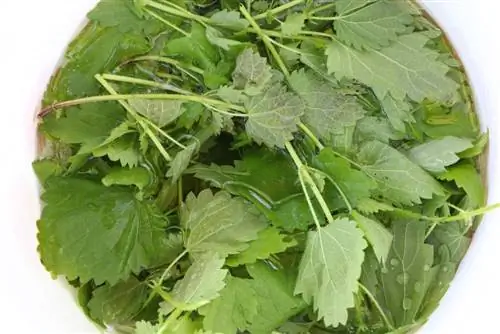
Nitrogen deficiency is quickly apparent in yellowing of the leaves. Watering with a mixture of nettles (Urtica), the best-known herbal fertilizer, can help.
Ingredients
- 1 kilogram of nettles
- 10 liters of water
Preparation and application
- Place nettles in a suitable container
- add cold water and let it soak
- Cover the vessel so that it is permeable to air
- let stand for three weeks
- Manure is ready when it starts to foam
- pour onto the roots at a ratio of 1:10
Tip:
Nettle manure not only supplies the plants with nitrogen, it also drives away pests. Diluted in a ratio of 1:10, the manure can be sprayed onto the leaves to combat aphids.
Fern manure
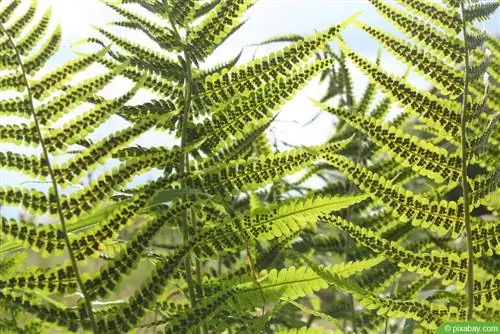
The fern manure is a tried and tested home remedy. It helps with a potassium deficiency and drives away snails and aphids from the garden. Worm fern (Dryopteris filix-mas) and bracken fern (Pteridium aquilinum) are good for making fertilizer.
Ingredients
- 200 grams of dried or 1 kilogram of fresh, chopped fern fronds
- 10 liters of water
Preparation and application
- Harvest fern fronds from June
- put in a container
- pour water over it, cover so that it can breathe
- stir daily
- The fern manure is ready when it turns brown and no longer foams
- Ratio 1:10 for heavy eaters
- Ratio 1:20 for plants with low nutrient requirements
Tip:
Fill the containers only halfway with the plant mass and add water to a maximum of 10 centimeters below the edge. Fermentation is associated with strong foam formation.
tansy broth
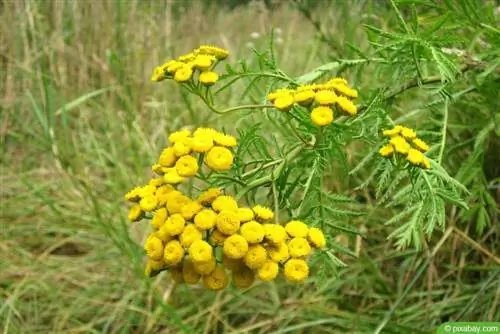
Rainsy (Tanacetum vulgare) is available almost everywhere. If it doesn't grow on your property, you'll find it in deciduous forests. Tansy broth provides your plants with important nutrients and repels pests such as strawberry mites and raspberry beetles.
Ingredients
- 300 grams of tansy fronds
- 10 liters of water
Preparation and application
- Collect and chop flowers, leaves and stems from July onwards
- pour water
- Let it sit for 24 hours
- bring to the boil briefly and strain through a sieve
- Spray on the plants in a ratio of 1:2
Attention:
tansy is poisonous. Protect yourself during preparation and use.
Rhubarb broth
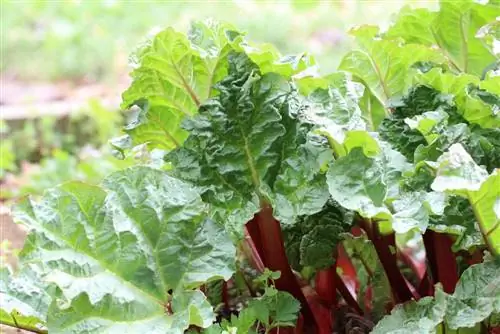
The large leaves of rhubarb (Rheum) are also ideal for making your own fertilizer. The broth supplies your plants with potassium and is used as an anti-lice agent and to combat brown rot.
Ingredients
- 1 kilogram rhubarb leaves
- 1 liter of water
Preparation and application
- Cut rhubarb leaves into pieces or strips
- put in a container
- fill with water and stir
- Leave covered for 24 hours
- Simmer on low heat for 30 minutes
- let it cool down
- pass through a sieve
- fill into small bottles
- spray undiluted onto the plants
Tomato manure

The shoots as well as stems and leaves of the harvested tomatoes (Solanum lycopersicum) can be fermented into manure and used as a growth promoter in the garden.
Ingredients
- 1 kilogram of stingy shoots and plant components
- 10 liters of water
Preparation and application
- Crushing plant parts
- Place in a container and pour cold water over it
- Cover air-permeable
- after two weeks the manure is ready
- Use as fertilizer in a ratio of 1:20
- to combat snails, water around the lettuce plants at a ratio of 1:1
Attention:
The lettuce leaves must not be wetted with the tomato liquid!
Wormwood Manure
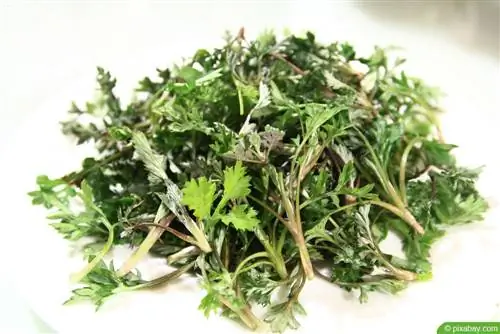
Wormwood (Artemisia absinthium) is considered one of the most important healing and home remedies. The bitter herb helps people with stomach problems. To keep your plants he althy, you can make your own wormwood manure in just a few steps.
Ingredients
- 300 grams of wormwood
- 10 liters of water
Preparation and application
- Crush wormwood, put it in a container, fill with water
- Let stand for two weeks, stir daily
- pour undiluted onto the roots
Attention:
Wormwood inhibits the development of compost. Do not put leftover manure on the compost.
Manure from weeds
Even if you don't have the herbs mentioned growing in your garden, weeds are always available. You can also make an effective plant manure from freshly pulled weeds.
Ingredients
- 1 kilogram of freshly pulled weeds
- 10 liters of water
Preparation and application
- Pour water over the weeds and cover them so that they can breathe
- let stand for two days
- stir and leave for another two days
- Weeds decompose
- when the fermentation process begins, the manure is ready for use
Attention:
Be sure to cover the manure container with boards or rabbit wire so that it is permeable to air to protect birds and pets.

